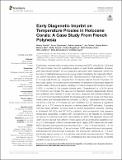Files in this item
Early diagenetic imprint on temperature proxies in holocene corals : a case study from French Polynesia
Item metadata
| dc.contributor.author | Rashid, Rashid | |
| dc.contributor.author | Eisenhauer, Anton | |
| dc.contributor.author | Liebetrau, Volker | |
| dc.contributor.author | Fietzke, Jan | |
| dc.contributor.author | Böhm, Florian | |
| dc.contributor.author | Wall, Marlene | |
| dc.contributor.author | Krause, Stefan | |
| dc.contributor.author | Rüggeberg, Andres | |
| dc.contributor.author | Dullo, Wolf-Christian | |
| dc.contributor.author | Jurikova, Hana | |
| dc.contributor.author | Samankassou, Elias | |
| dc.contributor.author | Lazar, Boaz | |
| dc.date.accessioned | 2020-07-22T08:30:01Z | |
| dc.date.available | 2020-07-22T08:30:01Z | |
| dc.date.issued | 2020-07-22 | |
| dc.identifier | 269245309 | |
| dc.identifier | d6714427-72b0-468b-8697-9f55ec7dfe3d | |
| dc.identifier | 85089067419 | |
| dc.identifier.citation | Rashid , R , Eisenhauer , A , Liebetrau , V , Fietzke , J , Böhm , F , Wall , M , Krause , S , Rüggeberg , A , Dullo , W-C , Jurikova , H , Samankassou , E & Lazar , B 2020 , ' Early diagenetic imprint on temperature proxies in holocene corals : a case study from French Polynesia ' , Frontiers in Earth Science , vol. 8 , 301 . https://doi.org/10.3389/feart.2020.00301 | en |
| dc.identifier.issn | 2296-6463 | |
| dc.identifier.uri | https://hdl.handle.net/10023/20304 | |
| dc.description | This study was supported through funds from ESF/CHECKREEF project (EI272/22-1 to AE; DU129/141-1 to W-CD; 20MA21-115944 and 200020-140618 to ES), by the collaborative research initiative CHARON (DFG Forschergruppe 1644 – Phase II) funded by the German Research Foundation, and by the GEOMAR Helmholtz Centre for Ocean Research Kiel. The Ph.D. program of RR was financially supported by the Tanzania Ministry of Education and Vocational Training (MoEVT) in collaboration with DAAD (Deutscher Akademischer Austauschdienst) fellowship. AR acknowledges support from Swiss National Science Foundation Project Number SNF 200021_149247. | en |
| dc.description.abstract | Coral-based reconstructions of sea surface temperatures (SSTs) using Sr/Ca, U/Ca and δ18O are important tools for quantitative analysis of past climate variabilities. However, post-depositional alteration of coral aragonite, particularly early diagenesis, restrict the accuracy of calibrated proxies even on young corals. Considering the diagenetic effects, we present new Mid to Late Holocene SST reconstructions on well-dated (U/Th: ∼70 yr to 5.4 ka) fossil Porites sp. collected from the Society Islands, French Polynesia. For few corals, quality pre-screening routines revealed the presence of secondary aragonite needles inside primary pore space, resulting in a mean increase in Sr/Ca ratios between 5-30%, in contrast to the massive skeletal parts. Characterized by a Sr/Ca above 10 mmol/mol, we interpret this value as the threshold between diagenetically altered and unaltered coral material. At a high-resolution, observed intra-skeletal variability of 5.4 to 9.9 mmol/mol probably reflects the physiological control of corals over their trace metal uptake, and individual variations controlled by CaCO3– precipitation rates. Overall, the Sr/Ca, U/Ca and δ18O trends are well correlated, but we observed a significant offset up to ± 7°C among the proxies on derived palaeo-SST estimates. It appears that the related alteration process tends to amplify temperature extremes, resulting in increased SST-U/Ca and SST-Sr/Ca gradients, and consequently their apparent temperature sensitivities. A relative SST reconstruction is still feasible by normalizing our records to their individual mean value defined as ΔSST. This approach shows that ΔSST records derived from different proxies agree with an amplitudinal variability of up to ± 2°C with respect to their Holocene mean value. Higher ΔSST values than the mean SSTs (Holocene warm periods) were recorded from ∼1.8 to ∼2.8 ka (Interval I), ∼3.7 to 4.0 ka (Interval III) and before ∼5 ka, while lower ΔSST values (Holocene cold periods, Interval II and IV) were recorded in between. The ensuing SST periodicity of ∼1.5 ka in the Society Islands record is in line with the solar activity reconstructed from 10Be and 14C production (Vonmoos et al., 2006), emphasizing the role of solar activity on climate variability during the Late Holocene. | |
| dc.format.extent | 19 | |
| dc.format.extent | 5530311 | |
| dc.language.iso | eng | |
| dc.relation.ispartof | Frontiers in Earth Science | en |
| dc.subject | Sea surface temperature (SST) | en |
| dc.subject | Chemical heterogeneities | en |
| dc.subject | Scleractinian corals | en |
| dc.subject | Diagenetic alterations | en |
| dc.subject | Biomineralisation and calcification | en |
| dc.subject | Late holocene climate | en |
| dc.subject | GE Environmental Sciences | en |
| dc.subject | NDAS | en |
| dc.subject | SDG 13 - Climate Action | en |
| dc.subject.lcc | GE | en |
| dc.title | Early diagenetic imprint on temperature proxies in holocene corals : a case study from French Polynesia | en |
| dc.type | Journal article | en |
| dc.contributor.institution | University of St Andrews. School of Earth & Environmental Sciences | en |
| dc.identifier.doi | https://doi.org/10.3389/feart.2020.00301 | |
| dc.description.status | Peer reviewed | en |
This item appears in the following Collection(s)
Items in the St Andrews Research Repository are protected by copyright, with all rights reserved, unless otherwise indicated.

